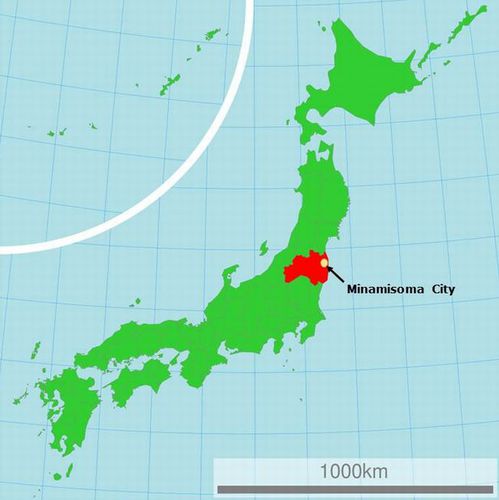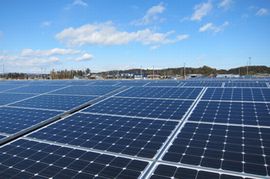June 27, 2015
Minamisoma Releases Non-Nuclear Power Declaration, Targeting 64% Self-Supplied Power by 2020
Keywords: Energy Policy Local government Renewable Energy

This map prepared by JFS is based on a map made by Lincun some rights Reserved.
Minamisoma City in Fukushima Prefecture became the first city in Japan to release a non-nuclear power declaration on March 25, 2015. More than 10 thousand citizens of Minamisoma continue to experience life as evacuees as the result of the Fukushima nuclear accident in 2011. The article to follow is reproduced in edited form with permission from Smart Japan. Smart Japan is an online publication specializing in energy conservation, storage and generation.
Non-Nuclear Power declaration of Minamisoma City shows its determination.
Non-Nuclear Power Declaration
Minamisoma City suffered unprecedented damage from the Great East Japan Earthquake on March 11, 2011. Furthermore, the accident at Tokyo Electric Power Company's Fukushima Daiichi Nuclear Power Plant forced the evacuation of over 60 thousand citizens from their homes. A large number of citizens lost their lives on the way to or after arriving at evacuation sites. Families, communities and regions are being torn apart, with many continuing to suffer from fear of the long-term effects of radiation exposure. Minamisoma City faces the challenge of rebuilding against the backdrop of this historic disaster. We have a responsibility to re-build communities where children can dream and hope for the future, and to prevent such nuclear accidents from ever happening again.
Therefore, the people have decided to build a new city that does not depend on nuclear power.
Minamisoma City here declares to the world its intention to be a nuclear power-free city.
Reconstruction Planning Department of Minamisoma City (in Japanese)
http://www.city.minamisoma.lg.jp/index.cfm/8,23464,75,html
In Minamisoma city, which faces the Pacific Ocean, over 600 people were killed in the Great East Japan Earthquake. Due to the radioactive contamination caused by the subsequent accident at Fukushima Daiichi Nuclear Power Plant, the population of the city, which was 70,000 before the disaster, had temporarily fallen to less than 10,000. As of March 2015, more than 10,000 people lived in other cities as evacuees.
At about 18 months after the disaster, the city set three basic principles; promotion of energy saving, positive use of renewable energy and establishment of a smart community. To eliminate its dependence on nuclear power, the city presented a measure to increase self-sufficiency to 64 percent by 2020, aiming to reach 100 percent by 2030.
Solar and wind power are the core of renewable energy, and 20% of their generation potential would meet the target level for 2030. If the construction of mega-solar power generation planned by Minamisoma city and Toshiba Corp., are realized, annual power generation will exceed 100 million kWh, more than 60 percent of the target level for solar power generation in 2020. The city plans to implement procedures to convert a farm land into solar power generation facilities under its reconstruction maintenance plan.


Copyright Fukushima Solar and Agriculture Experience Association All Rights Reserved.
Also sponsored by Toshiba, "Minamisoma Solar Agripark" where a solar power plant with a generating capacity of 0.5 megawatt has been constructed started operations in March 2013, aiming at a new style of agriculture.
In the two domed plant factories on its property, vegetables are cultivated using electricity generated by the solar power plant. Growing safe vegetables using renewable energies, and not depending on nuclear power, it has been positioned as a symbol of agricultural revitalization toward disaster recovery.
Minamisoma city intends to realize a recycling-oriented "Eco-friendly Future City". Along with securing the environment for locally produced renewable energy for local consumption, the city will build smart communities of 30 households per village. On the industrial side, making use of the plant factory, it plans to create a circulating local industry that encompasses everything from production, processing and sales to energy supply of agricultural products.
Overcoming radioactive contamination damage and continuing efforts to create a city for future generations will lead to disaster restoration. These thoughts are expressed in the document of the "Declaration for a Nuclear Power-Free City".
How seriously do electric companies and the government take this declaration? At four years since the disaster, the movement to reopen nuclear power plants has steadily continued. Cities such as Minamisoma city need to carefully consider the pros and cons of the plants to be restarted after assessing the situation of communities that are struggling to overcome radioactive contamination.
Source: Smart Japan (in Japanese)
Related
"JFS Newsletter"
- 'Yumekaze' Wind Turbine Project Connects Metro Consumers and Regional Producers: Seikatsu Club Consumers' Co-operative
- Shaping Japan's Energy toward 2050 Participating in the Round Table for Studying Energy Situations
- Nishiawakura's Initiative for 100% Energy Self-Sufficiency, and a Municipal ICO Scheme
- Actions Toward 100% Renewable Energy in Japan
- Sustainable Community Building in Shimokawa: Recycling-Oriented Forest Management Enabling Permanent Use of Forest Resources
Related
"Popular Articles"
- Current Status of Renewable Energy in Japan (2015)
- Offshore Wind Farm Withstands Great East Japan Earthquake and Tsunami
- Current Status of Renewable Energy in Japan (2014)
- Geothermal Power: Japan Has World's Third Largest Geothermal Reserves, 60 Percent of Which Can Be Developed
- Tokyo Plans to Increase Renewable Energy Ratio to 20% by 2024


